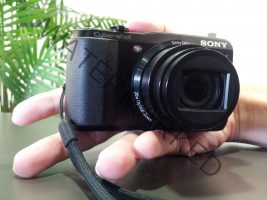After visiting the SEA Aquarium and having an extensive collection of shootings (over 500+), I have some thoughts about shooting in the aquarium to share with you guys.
1. Bring an Extra Battery or Two
If you never or rarely visit the aquarium, it is very easy to over-shoot. You may have multiples shots for each scene to ensure that you have at least one or few good shots for that scene. I almost used up two fully charged batteries throughout the tour. Each of them lasts for around 300 shots.
2. Use a Lens with Wide-Angle Focal Length and Large Aperture
Focal length between 24 and 50 mm (in 35 mm equivalence) is recommended because they have a wider angle of view and allow you to shoot closer to your subject. A larger aperture allows more light so that you do not need to bump up too much ISO. Be careful here, large apertures like F2, F1.8, and any smaller F values, will have a tiny part of the subject in focus. I used the Sony SEL24F18Z and kept my aperture between F2.8 and F5.6 to get enough DoF while having a large enough aperture to maintain a lower ISO.
3. Use Manual Mode
The lighting condition in the aquarium is complicated due to the artificial lighting and is mainly in a very dark situation. If you are using A mode, then the shutter speed may fall below the safe shutter speed easily and blur your shots. Besides, the fish are not “static” for you to shoot. They are always swimming, and you may need a shutter speed of 1/80 to 1/125 s to shoot a clear image of fish.
4. Bump up ISO
After setting the shutter speed and the aperture to your desired settings, but you still experience a badly underexposed, it is time to bump up your ISO. ISO 400 to 3200 can capture enough light while maintaining reasonable image quality (It depends on how good your camera handles with high ISO). I took most of my shots in ISO 800 or ISO 1600, and the quality is acceptable.
5. Shoot in RAW
Most of us may not have so many experiences shooting in the aquarium. The entrance ticket is not so cheap, and you probably won’t want to pay again just for shooting some previous missed/foul shots. RAW files allow you to have more control and adjustment in the post-processing. It will save your shots, and the most important is to save your money!
6. White Balance in the Aquarium is Different!
Auto white balance works well in most of the case. If you are going to shoot some portraits in the aquarium, set your temperature to a higher value. Usually, it will need a value of over 7K so that your face won’t look like blue and green (unless you want to take some horrible effects).
7. Think About the Composition
What do you want your shots to be? A closed-up “big head” shot?
Or do you want to capture the environment together with fish?
You may try a different look and feel for your shots. Just ensure you have enough memory space and battery for your remaining tour.
8. Be Patient in the Aquarium
There is a lot of fish in each display panel, and they are “LIVE”. The fish may give you a “U-turn” suddenly at the moment you have pressed the shutter. Please do not give up, be patient, observe the behavior of the fish, compose your shoot nicely, wait for the fish to reach the desired spot, and then shoot it.
9. Shoot Closer
A quote from a famous photographer: Robert Capa “If your photographs are not good enough, you are not close enough”. For shooting in the aquarium, shooting closer will remove the unwanted reflection too. If you have a soft rubber lens hood, attach it to your lens and stick it on the glass of the display panel. If your lens hood is made of plastic or other hard materials that do not allow you to attach your lens hood onto the glass, you may shoot perpendicular to the display panel.
10. Forget About Your Flash in the Aquarium
The most important tip to be remembered is to keep your flashlight in your bag or off it when shooting in the aquarium. You will notice that there are many notice/warning boards pasted above the display panel, which disallowed any flash photography. Please be considerate and show people that you are a respectable photographer even using a compact digital camera. Besides, on-camera flash will yield the undesired reflection of the glass of the display panel. So keep your flash off is good for both of your shots and image.
That’s all for today’s post, and I hope that you may get a little help from it. You are welcome and appreciate to share your experiences here so that to help each other as well =)








